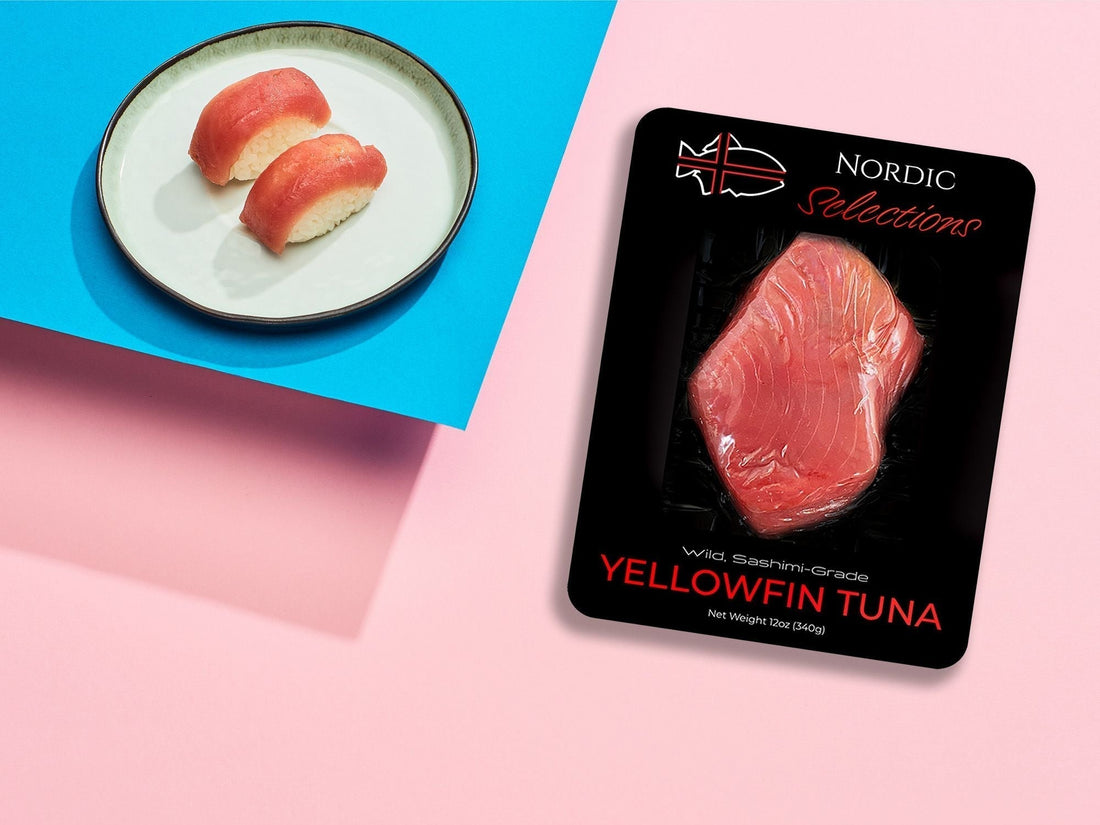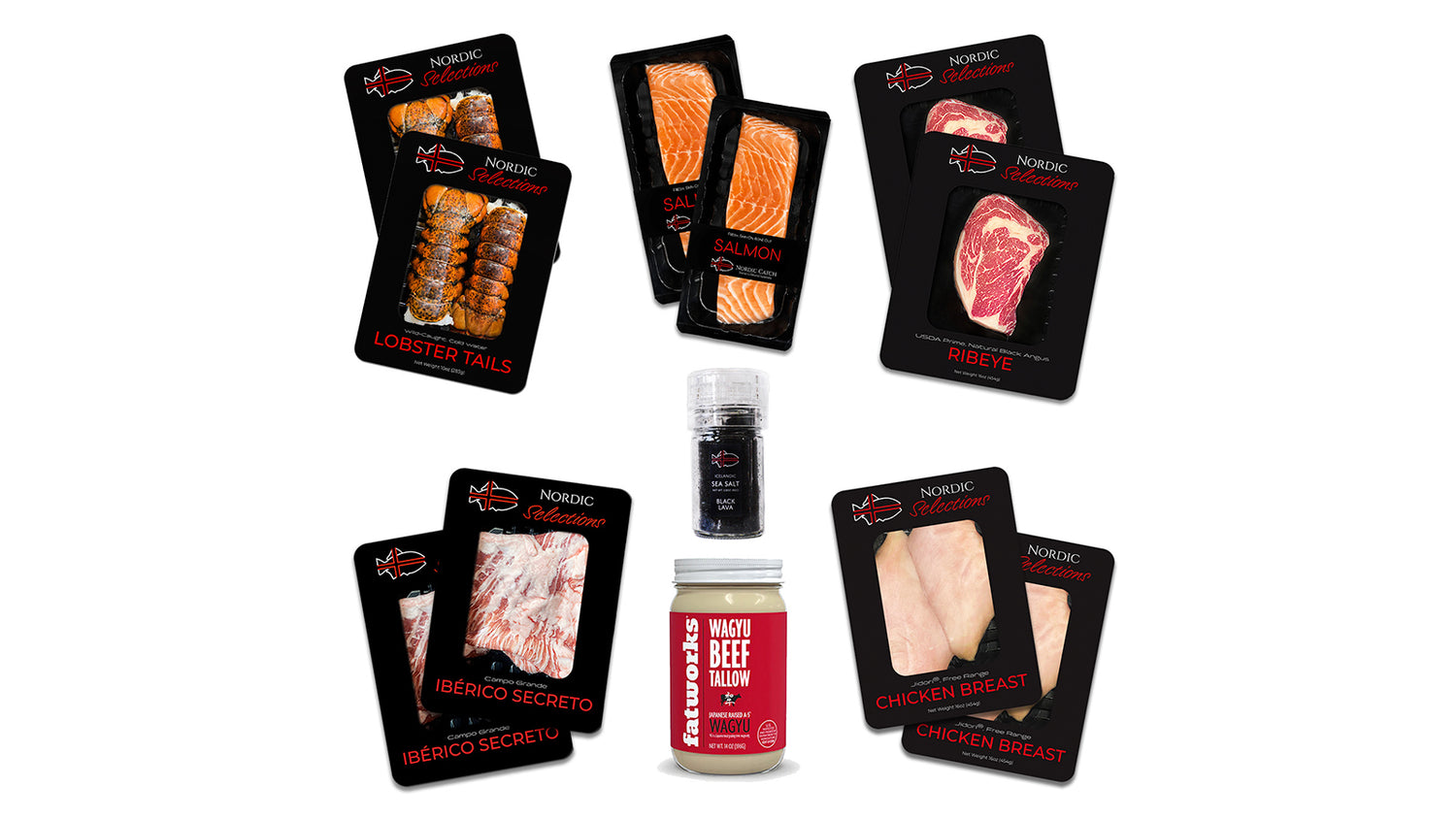
Sashimi vs Sushi: What’s The Difference?
We've all been there, staring at the menu of a new sushi restaurant and wondering, "What exactly is the difference between sashimi and sushi?"
Both sashimi and sushi feature seafood, but they differ slightly in their preparation. Whether you're buying sushi-grade fish online or browsing your local sushi restaurant's menu, knowing what you're getting is essential, so let's dive into the specifics.
What Is Sashimi?
Sashimi is a Japanese dish of thinly sliced raw fish or seafood, typically served with soy sauce, wasabi, and other garnishes. It differs from sushi, which includes vinegared rice (sushi rice). Sashimi is the purest form of raw fish and seafood, sliced thinly and served independently of rice, vegetables, or other accompaniments.
Common Types of Sashimi
- Tuna: Chefs serve tuna, or "Maguro" in Japanese, as Akami (lean tuna), Chutoro (medium fatty tuna), and Otoro (fatty tuna). Fattier cuts have a richer flavor than leaner cuts and are less rigid, as there's little to no muscle to chew through.
- Salmon: Salmon sashimi is immensely popular because of its soft, buttery texture and rich flavors. Its fresh and subtly sweet taste makes it a favorite among many Sashimi aficionados.
- Yellowtail: Commonly known as Hamachi, Yellowtail has a firm texture, high-fat content, and mild, buttery flavor. Note that Hamachi is different from Yellowfin tuna, also called Ahi.
How to Prepare Sashimi
In Japan, it generally takes ten (10) or more years of dedicated training before an individual is qualified to cut and prepare authentic sashimi.
However, if you want to prepare sashimi at home, you must ensure you get started for ten (10) years or change career paths. To prepare the best sashimi, you must use fresh, never-frozen fish since frozen seafood has a different taste and texture. Even flash-frozen seafood is lower in quality than fresh seafood.
Beyond that, you must use one of three specialized knives to achieve the ideal taste and texture:
- Yanagiba: A slender knife primarily for slicing sashimi (raw fish) into thin, precise slices. Its design allows for a smooth, single-pull cut, preserving the fish's texture and freshness.
- Takohiki: Similar to the Yanagiba but with a squared tip, it is traditionally used to slice octopus (tako) and other ingredients. The flat edge and straight design make it ideal for cutting dense or sticky fish like octopus.
- Fuguhiki: A specialized knife for slicing fugu (pufferfish), known for its sharpness. It's thinner than a Yanagiba to allow for ultra-thin, translucent cuts of the delicate and potentially dangerous fugu meat.
Unlike sushi, sashimi doesn't require rice or rolls—just a bit of soy sauce, wasabi paste, pickled ginger, or any other small accompaniments you desire.
What Is Sushi?
Sushi is a Japanese dish typically consisting of vinegared rice and various ingredients, including raw or cooked seafood, vegetables, and sometimes tropical fruits. Chefs often serve it in rolls or as individual pieces.
To reiterate — sushi can consist of raw or cooked seafood; not all sushi is necessarily raw fish. Popular dishes like shrimp tempura and California rolls both consist of cooked seafood.
Common Types of Sushi
- Maki: When you think of sushi rolls, you probably envision maki, consisting of sushi rice, raw fish, and/or vegetables rolled into Kimnori seaweed.
- Nigiri: An oval-shaped sushi rice mound hand-pressed below a thin slice of raw fish or seafood, nigiri contains nothing besides raw fish and rice (and occasionally seaweed).
- Uramaki: Uramaki, or inside-out rolls, are the reverse of maki. In these sushi rolls, the rice occupies the exterior, and the nori (seaweed) encases the ingredients internally. A garnish of sesame seeds or fish roe may provide extra texture.
- Temaki: A distinct serving style for sushi, temaki consists of sushi rice, raw or cooked fish, and vegetables encased within a cone-shaped, hand-rolled nori sheet.
How to Prepare Sushi
The preparation methods for sushi and sashimi differ since sushi contains more garnishes and ingredients, including rice. Again, while Japanese sushi chefs train for ten (10) years, you can make your sushi at home with some sushi rice, raw fish, vegetables, and a bamboo sushi rolling mat.
Maki is one popular form of sushi. Making maki involves rolling sushi rice and fillings inside a sheet of nori. First, spread an even layer of cooked, seasoned sushi rice on the rough side of the nori, leaving about an inch at the top. Add your desired fillings, such as cucumber, avocado, or fish, in a line near the bottom. Carefully roll the nori over the fillings using a bamboo mat, pressing gently to form a tight roll. Wet the top edge of the nori to seal the roll. Finally, slice the roll into bite-sized pieces with a sharp knife and serve.
Sashimi vs. Sushi: What Are the Differences?
|
Element |
Sashimi |
Sushi |
|
Ingredients |
Raw seafood only |
Raw or cooked seafood, rice, and other ingredients |
|
Rice |
Not present |
Present |
|
Seaweed |
Not present |
Present |
|
Serving Style |
On a bed of sliced radishes |
Rolled, layered, or folded |
|
Eating Style |
Chopsticks |
Fingers or chopsticks |
Nutritional Content
From a nutritional standpoint, sashimi and sushi differ slightly. Since sashimi does not contain rice, there are far fewer carbohydrates (nearly 0 grams) in a serving of sashimi. With the rice in sushi, a standard sushi roll of 6-8 pieces can contain 25-35 grams of carbohydrates and pack an extra 140 calories compared to sashimi. If you're conscious of your macronutrient intake, sashimi is better for weight loss.
However, both sashimi and sushi are excellent sources of protein and omega-3 fatty acids, though certain seafoods are healthier than others.
Frequently Asked Questions
What are the primary distinctions between sashimi and nigiri?
Sashimi is raw fish served without rice, while nigiri is sushi rice topped with seafood.
How are sashimi and sushi served?
Sushi is rolled and cut into bite-sized pieces, while sashimi is thin slices of raw fish served with soy sauce and wasabi.
What are the common types of fish in sashimi?
Tuna, salmon, and yellowtail are common in sashimi.
How does dining etiquette differ for sashimi and sushi?
Etiquette differs for handling soy sauce, wasabi, and ginger, depending on whether you're eating sashimi or sushi. Sushi is meant to be finger food, whereas sashimi should be eaten with chopsticks.

